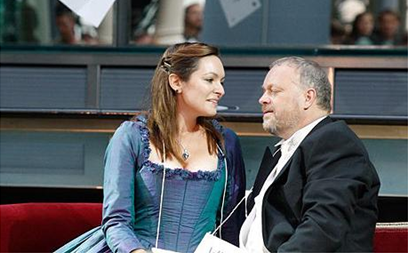Performing Arts 2.0
So there’s a lot that’s been written about Museums 2.0. But what about Performing Arts 2.0? Are there theaters, symphonies, or dance companies out there that are using technology to encourage creative audience participation? Is anyone going beyond tweeting during performances (which is really commentary) to actually getting audiences’ input into the resulting artistic product, or encouraging audiences to create something of their own? Well, it took some of digging, but I found some. And they are way cool. Performing arts organizations- take note!
The Twitter Opera- Royal Opera House
-

-
Hannah Pedley and Andrew Slater perform. Photo by Andrew Crowley.

Some of you may remember Twitterdammerung, the world’s first Twitter opera that premiered last year in the lobby of the Royal Opera House. Over 900 people contributed to the opera’s plot and dialogue in less than 140 characters at a time. The tweets were abridged and compiled into a libretto by John Lloyd Davies, Director of Opera Development, and Helen Porter and Mark Teitler wrote the score in three days. Although the plot had “little rhyme or reason,” it was surprisingly not lambasted by the critics, one of whom called it a “decent operatic sketch show.” The audience enjoyed the humor and operatic references; although Davies points out that nothing this frivolous would ever be on the main stage.
VirtuARTsity- the Appel Farm
Here is a description of the program from their press release:
VirtuARTSity.org is a unique website . . . created with the goal of creating a forum for people with artistic interests to post their own work, view other work being done by artists from across the region, and join a community of like-minded people for dialogue and knowledge-sharing. Once a person registers on VirtuARTSity.org they can create their own interest-based group and invite friends, or join a discussion. Posting videos, blogs and audio files are more ways for people to connect as artists, and to have an outlet for their work. . . .
This site has excellent potential but still seems to be on training wheels- there’s not a whole lot of content yet and I don’t see a space for users to interact directly with sponsored artists. But there are some amazing user-uploaded pieces of art there, and it will be exciting to see what this turns into once it gets going.
Singing Contest, Choose Your Own Adventure Concert, and People’s Choice Concert- Arkansas Symphony Orchestra
This little orchestra has big ideas for transforming the audience’s experience at the symphony. On July 4, selected singers chosen by audience vote and a panel of judges will compete in front of a live audience to sing the National Anthem with the ASO as a part of the Oh Say Can You Sing competition. Anyone can upload a youtube video of themselves singing the anthem to the contest website—the local newspaper even sponsored a day at a mall where those without cameras could come and get filmed. Music Director Philip Mann reports that the competition was extremely popular last year and that continuing it this year was a high priority.
-

-
Oh Say Can You Sing? is sponsored by the Arkansas Democrat-Gazette

This year, kids in attendance for the annual children’s concert will get to choose their own concert live. The concert will be based on a character’s adventures, and the kids will vote by show of hands what the character should do next, with different pieces resulting for the different resulting adventure. Mann says that he tried this first at the San Diego Symphony, where jumbotrons and cameras made the experience more similar to a rock concert than the traditional symphony concert.
And last but not least- a People’s Choice concert. Audiences will get to choose from a list of pieces and vote throughout the year via social media, email, and text messaging, up until intermission of that night’s concert.
Virtual Choir- Eric Whitacre
Now, I know Eric Whitacre is not a performing arts organization in and of himself, but his Virtual Choir can’t get any more 2.0. Inspired by a young woman who posted a YouTube video of herself singing the soprano part to one of his works, Whitacre sent out a request for videos of all the parts to his piece “Lux Aurumque.” With a video of him conducting to keep everyone together, hundreds of singers from around the world sent in their submissions. There was even an audition for a solo part. The result, edited together by Scott Haines, is beautiful. There was a sequel this year, a performance of Whitacre’s “Sleep” with even cooler graphics, more singers, and subtitles.
Hot City Theatre and Lia Romeo
Recently, Hot City Theatre announced that thanks to a grant from PNC Arts Alive (who also funded VirtuARTsity, above), they were commissioning a play from Lia Romeo that will integrate social media into the play. The play is still being written, but a statement from Romeo suggests that it will incorporate input from the audience.
To me, one of the most interesting things about the rise of social media . . . is the way it has turned the communication of information from a one-way into a multi-way conversation. It struck me as interesting that most theater is still a one-way conversation, and I started thinking about ways to get the audience actively involved in commenting on or even shaping the direction of a piece of theater in real time, as it was going on.
It’s going to be interesting to see how performing arts organizations use (or resist) new technology and new ways of thinking about and interacting with art. Do you know of anyone using technology to engage audiences in creating art? Share your examples below!